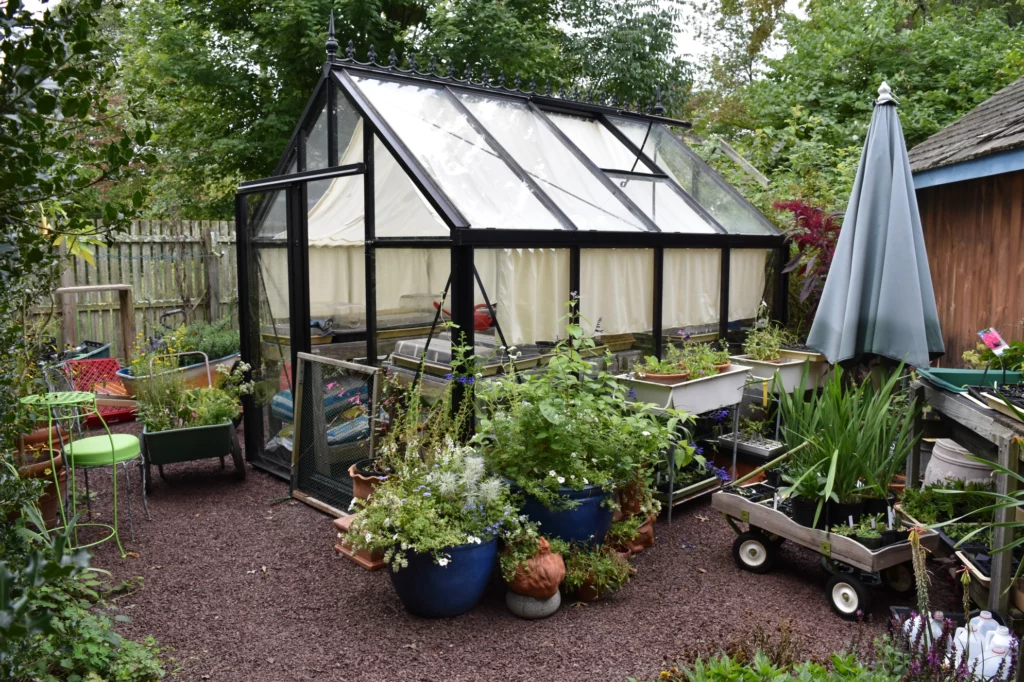
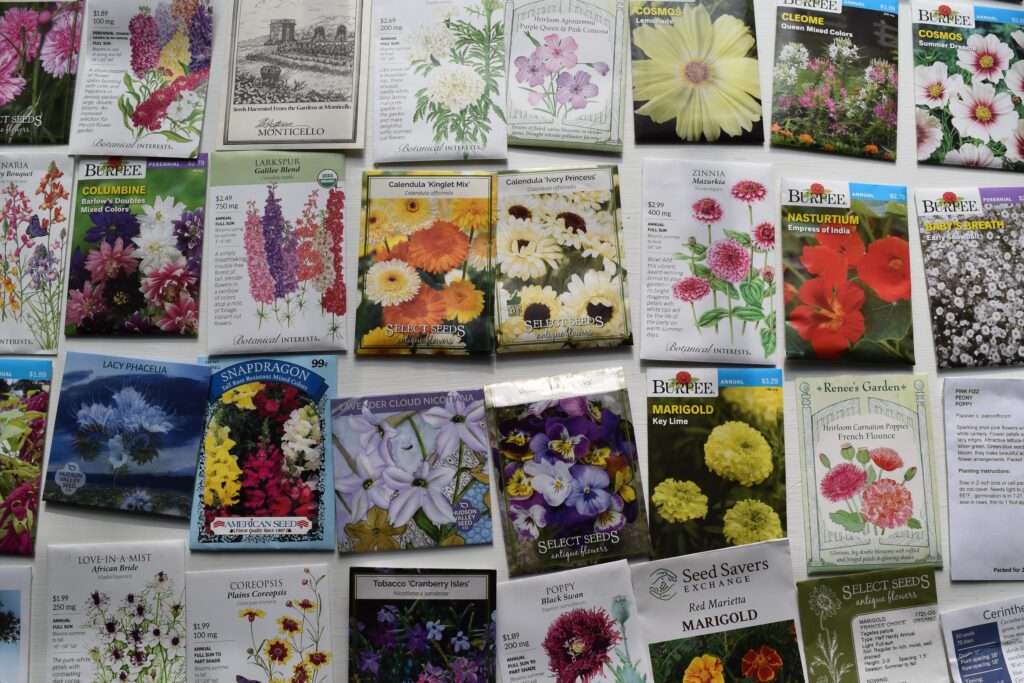
Choosing which seeds to sow
Seed sowing is one of the ultimate gardening pleasures. Tucking tiny brownish bundles of potential beauty beneath your potting soil is a lesson in hope and expectation.
My Head Gardener, here at Northview Garden, Hanna von Schlegell, and I spend a lot of time thinking, and occasionally debating which flowers we are excited about this coming year. Here are some of our choices that we will be planting in 2023. Some of these are new varieties, and others are tried and true that we sow most years.
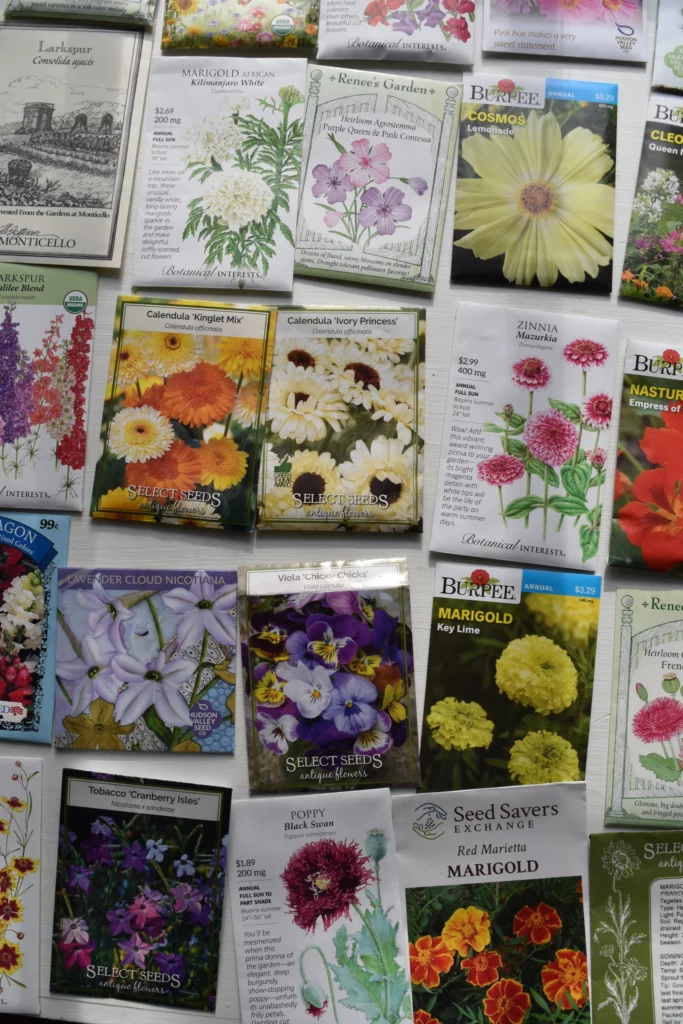
Collecting your seed packets together is a good first start before choosing what to plant first.
When I think about growing flowers from seed, I get so excited! Over the last few months, I have been buying and hoarding packets of seeds like a squirrel with its winter store of nuts. Now it is the time to choose which ones will get planted and given pride of place in the garden. The other seeds may be sown directly in the soil outside or will be in the second batch of plantings.
Cool-Season Annuals from Seed
Cool-season annuals can take some cold weather so they are the earliest ones to be sown. They can be sown directly outside – for us in Zone 6-7 we wait until the middle of March. We also sow some in our little unheated greenhouse here at Northview Garden.
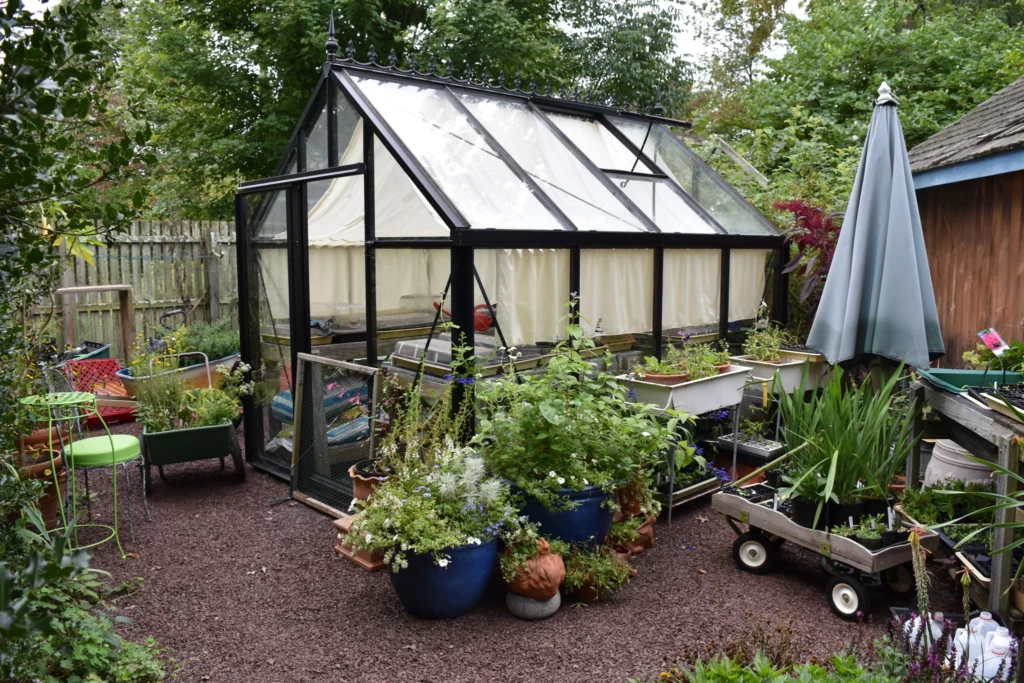
Sweet peas
Let’s start with sweet peas. I grow them every year because I love them so much. I only choose fragrant ones otherwise it defeats the point. These are not the edible peas that I also grow. The decorative ones are poisonous – so don’t get them muddled up. Sweet peas grow easily in some climates, like in Britain, but not in eastern Pennsylvania. Our springs are erratic and all of a sudden, the weather heats up. Sweet peas love consistently cool and not blasting hot. Over the years I have set the bar lower and lower in this garden. If I get a few bunches of fragrant flowers, I am happy.
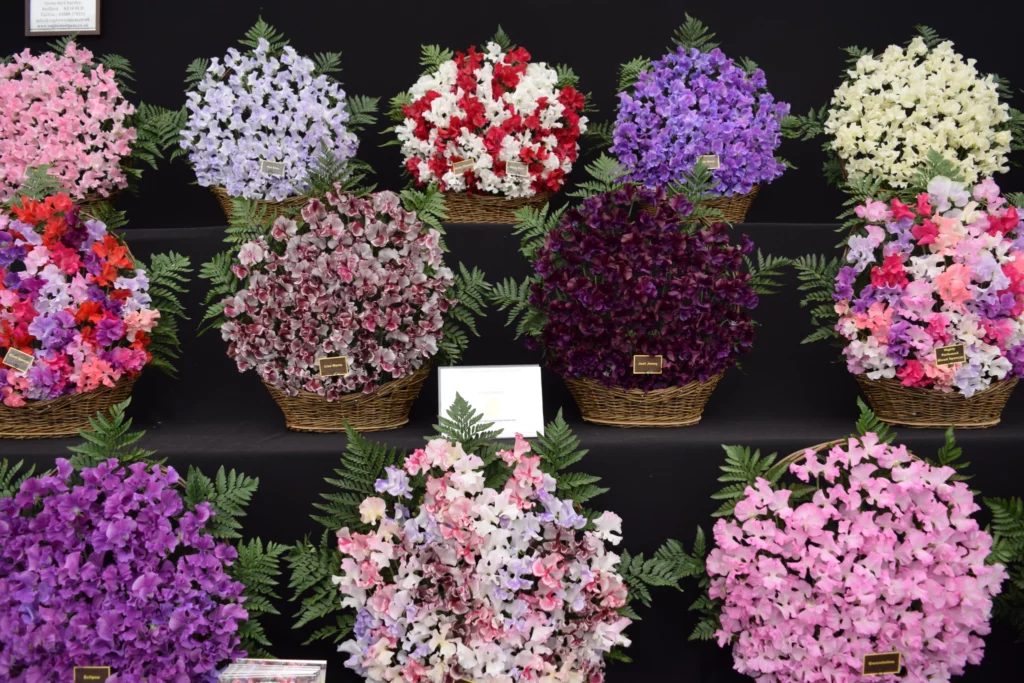
Sweet pea display at the famous Chelsea Flower Show in London – imagine the scent!
In my old garden in Buckingham, England, I would poke seeds in a zig-zag row beside a trellis attached to a six-foot-high fence. All the seeds would easily germinate and produce endless flowers to pick every day. Here we try every method possible to get my coveted sweet peas. We plant some in fall, some in an unheated greenhouse, and then some in the ground on St. Patrick’s Day (March 17th). You may ask – is it worth it. To me, it is for one whiff of that delicious sweet pea scent.
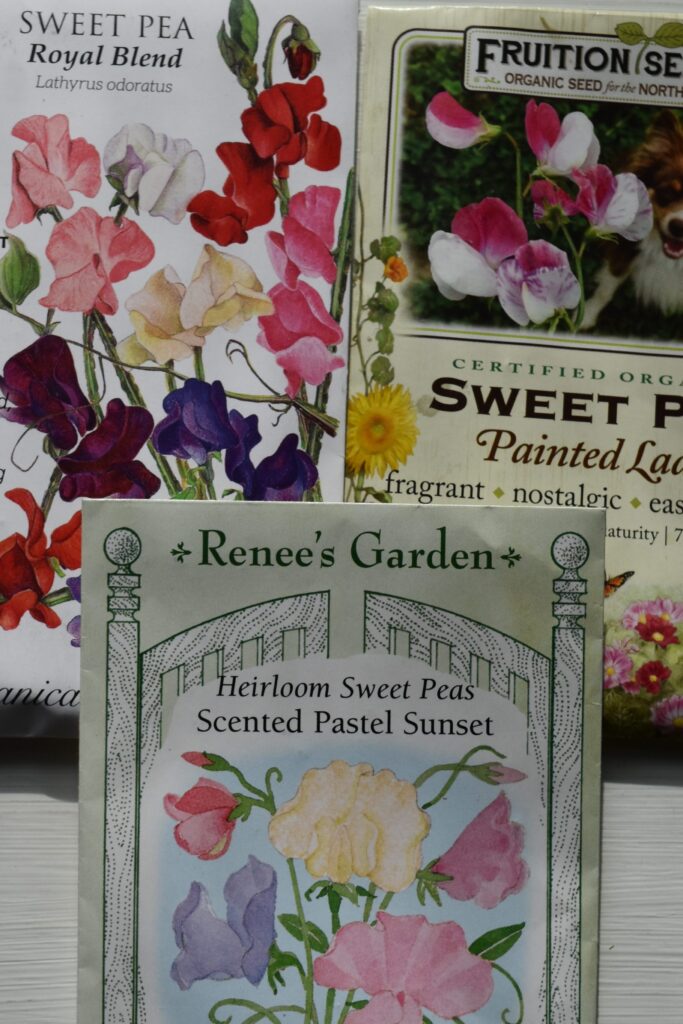
Fragrant sweet peas grown from seed are a must at Northview Garden – these are from Botanical Interest, Fruition, and Renee’s garden seeds.
Calendula and Borage
Another couple of favorite cool-season annuals that are fantastic additions to the late spring garden are the pot marigold (Calendula) and borage (Borago). These are both herbs, and edible – great thrown into salads or frozen into ice cubes and they look great growing together. I will be growing a couple of types of Calendula. I love the bright orange, cream, and yellow collection in Select seeds ‘Kinglet Mix’ and will be trying the creamy ‘Ivory Princess’.
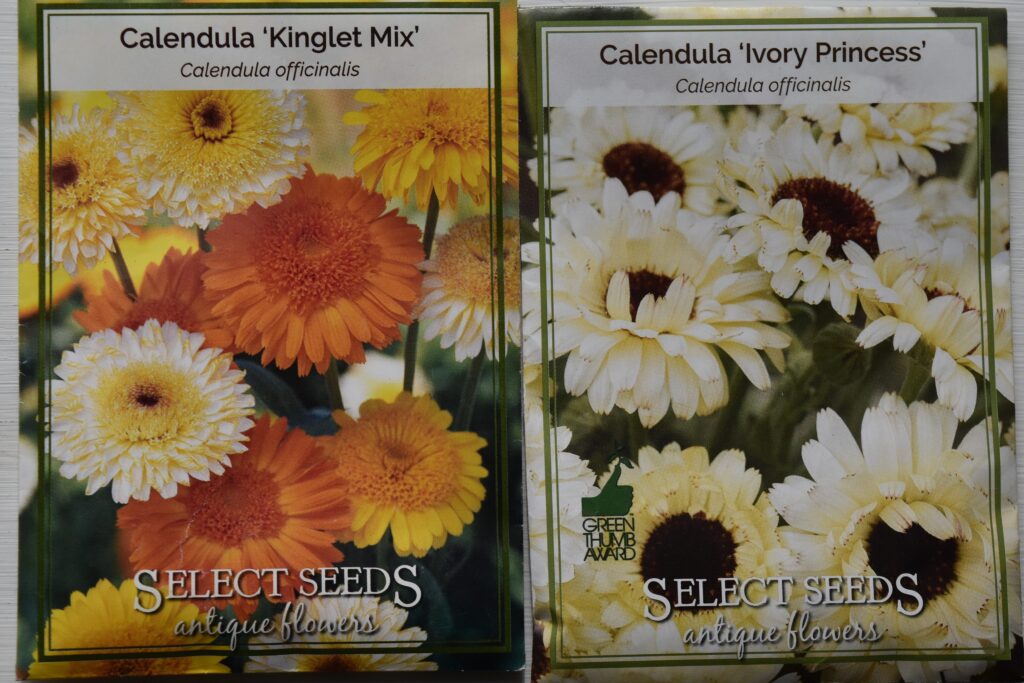
Calendula, sometimes called English Marigold, or Pot Marigold, ‘Kinglet Mix’ and ‘Ivory princess’ from Select Seeds
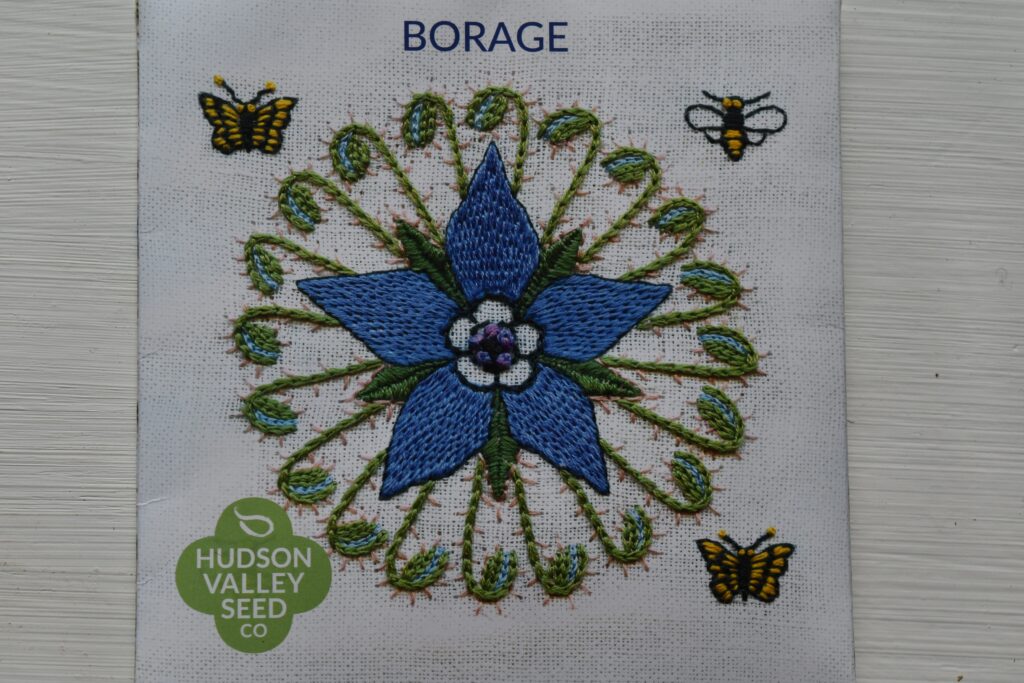
This lovely seed packet of blue, star-like borage flowers is from Hudson Valley Seed Co.
Centaurea
Centaurea or cornflower is another cool-season annual that is usually bright blue. I love the blue, but I am also going to try a pink one from Select Seeds called ‘Pinkie’. I will let you know what I think when it flowers. Hanna is going to try the Centaurea ‘Classic Romantic Mix’.

Centaurea ‘Pinkie’ is a pink Cornflower from Select Seeds
Warm-Season Annuals Grown from Seed
Warm-season annuals are planted after you have got the cool-season ones going. These need to be mollycoddled and if grown inside need to be gradually acclimatized to being outside in the spring (a process called hardening off). Later sowings can be made directly into the soil after it has warmed up to about sixty degrees Fahrenheit. Or as one of my friends said, ‘the soil is warm enough to sit on’.
Zinnias

Wouldn’t you like Zinnia ‘Mazurkia’ to be the life of your garden party? From Botanical Interest Seeds.
I have my eye on several lovely zinnias. There is a new one that is pink with white tips to the petals called Zinnia ‘Mazurska’. It looks fantastic on the packet – we will have to see how it looks in my garden and vase. I like to have a variety of sizes of zinnias to use in different-sized arrangements, so I will be growing the diminutive button-like ‘Thumbelina’ and a glowing pink one called ‘Luminosa’. The old favorites are sometimes the best and the most reliable, so I always grow ‘Cut and Come Again’. I have lots of packets of that one Hanna tells me. Hanna is going to try a new zinnia that is called Cupcake series mix. Sounds interesting but also confusing since we also grow Cosmos ‘Cupcakes’. Surely there are other names that the plant namers could use.
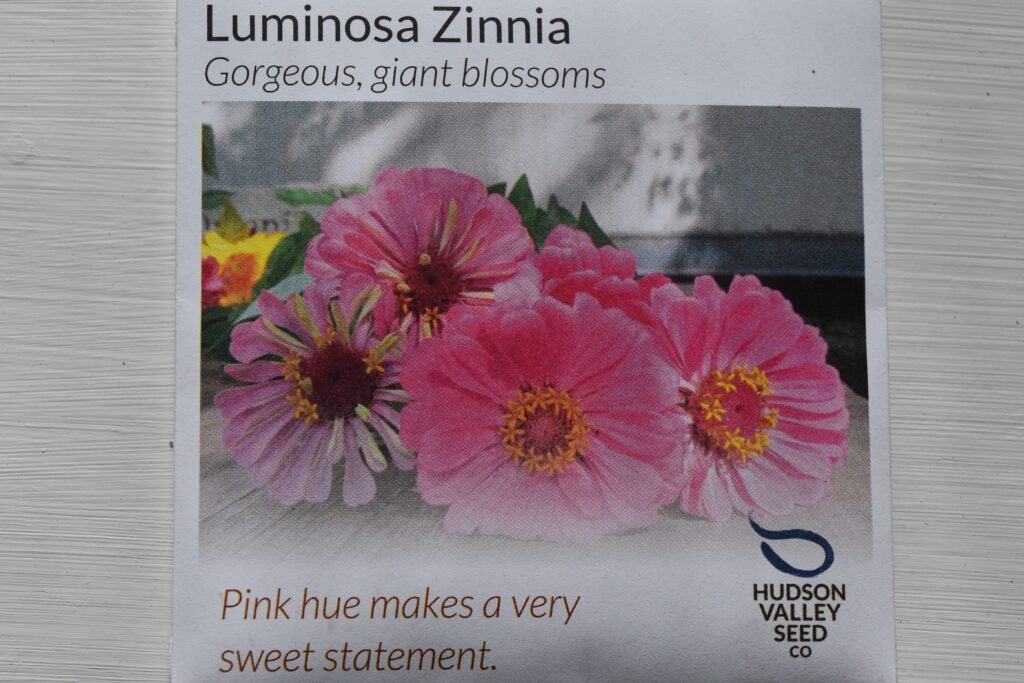
Luminosa Zinnia seeds from Hudson Valley Seed Co.
Celosia
Following on with a pink theme I want to grow more Celosia ‘Flamingo Feather’. I had one plant last year that was at least 8 feet tall. One visitor to Northview last year said that it would be way too tall for her little garden, but I think whatever the size of your garden, don’t be afraid of tall plants, especially annuals that you can change out next year if you don’t like them.
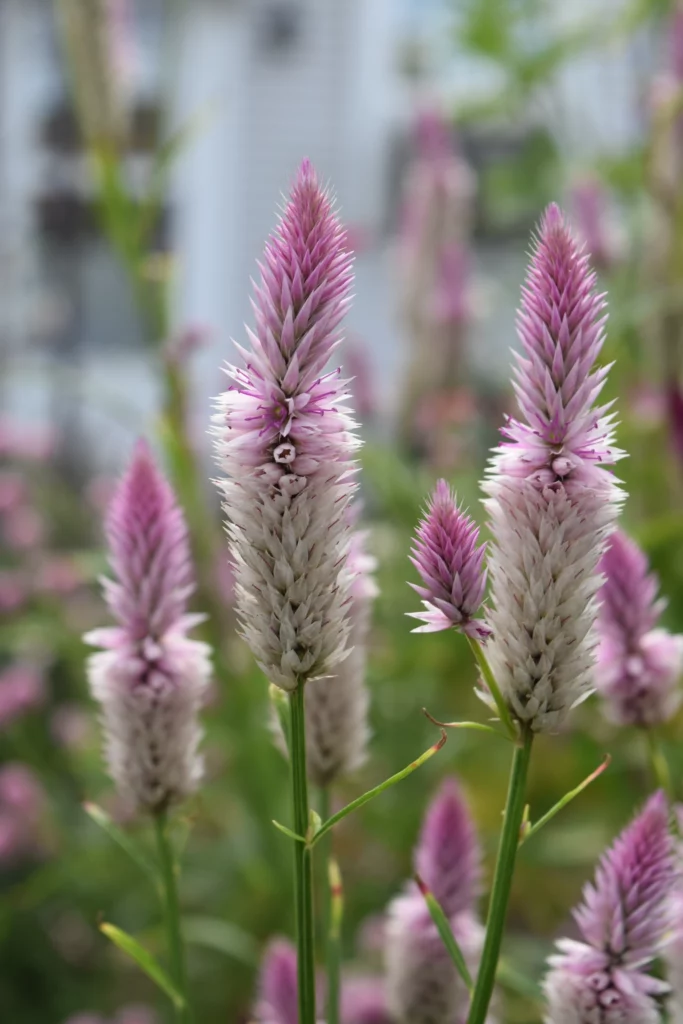
I love this annual plant – Celosia ‘Flamingo Feather’ – great in the garden and the vase
Growing Flowers for Pollinators
Coreopsis, single Dahlias, and Tithonia
Hanna is excited to grow Coreopsis tinctoria. It is a native that attracts butterflies. We do a lot of planting for pollinators so even if plants are not native, we grow single flowers (as opposed to double fluffy flowers) so that passing pollinators can access pollen and nectar easily. There is a seed-grown dahlia that Hanna is going to grow for this reason. It is called ‘Bishop’s Children’. You may be familiar with the bright red single dahlia with dark foliage called ‘Bishop of Llandaff’ that is the darling of gardening magazines and flower beds, these are cross-pollinated seeds from those parent plants. We will see what we get.
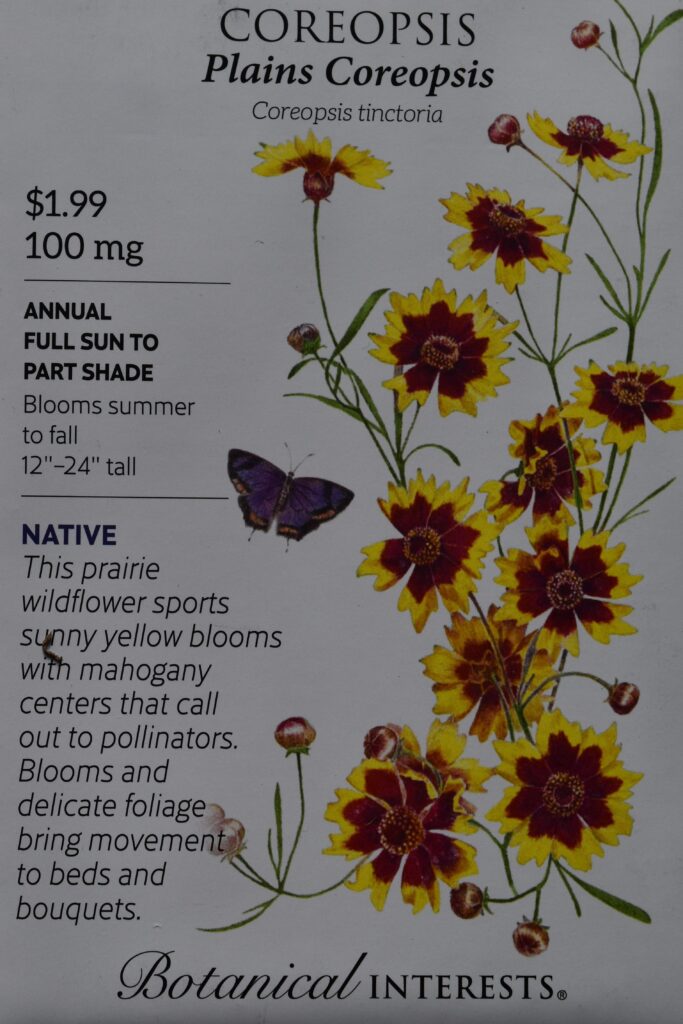
Coreopsis tinctoria – Hanna wants to grow this flower from seed for pollinators especially butterflies. From Botanical Interests.
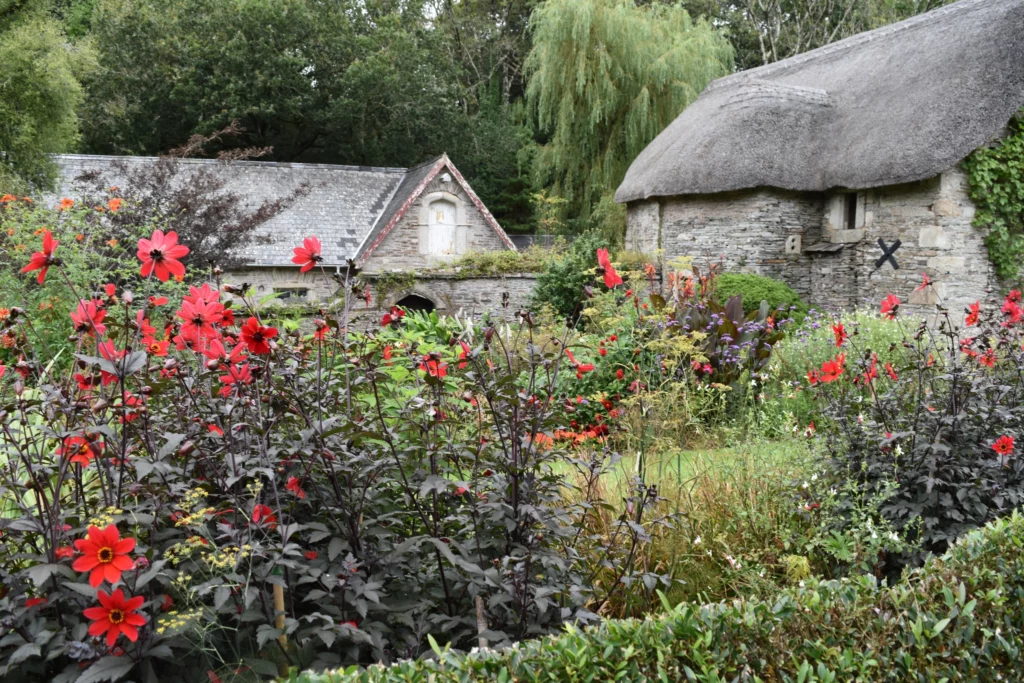
The red, single-flowered, dark leaved Dahlia ‘Bishop of Llandaff’ growing at The Garden House in Devon, England
Another annual plant that we grow every year for its late season height and butterfly attractiveness is the Mexican Sunflower, Tithonia. I only like the 8-foot tall one, (maybe there is theme of tall plants), not the 3-4 foot one that seems rather pointless. You want the blooms up high so that migrating monarchs can find them waving in the breeze.
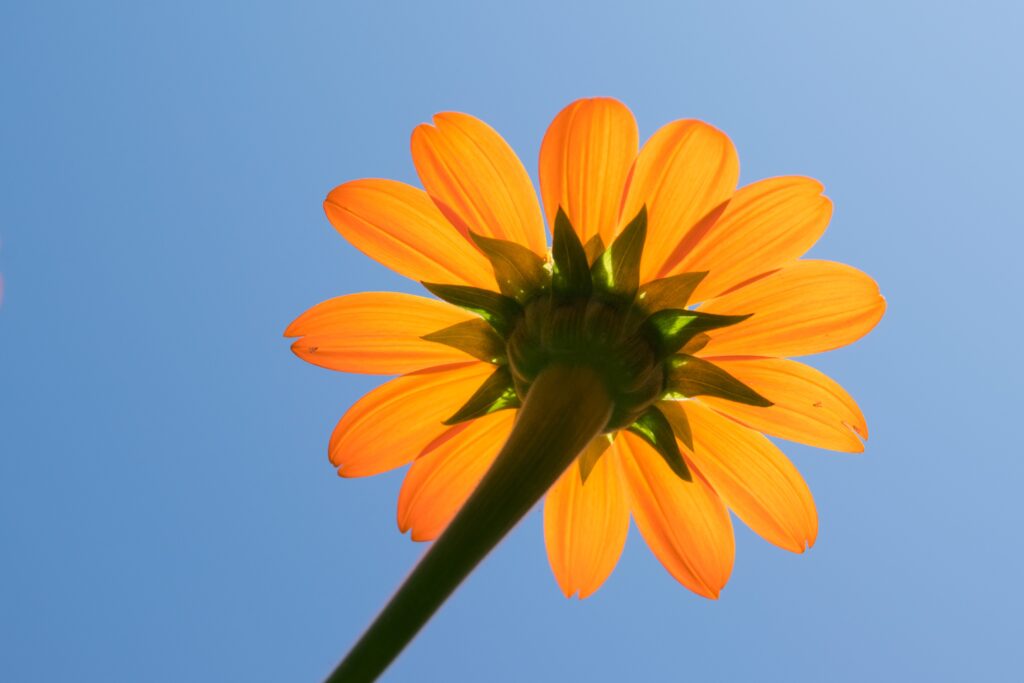
I love a flower that I can look up to – here is a tall Tithonia or Mexican Sunflower in my autumn garden.
Final Seed Sowing Pick
Nicotiana – Flowering Tobacco
One more choice and then we better get on with planting. My last pick is the whole genus of Nicotiana. The garden plants are known as flowering tobaccos (not a particularly attractive name for a decidedly delicate, often fragrant, and pollinator-attracting flower). The basic flower shape is a star from the front, with a tube behind it.
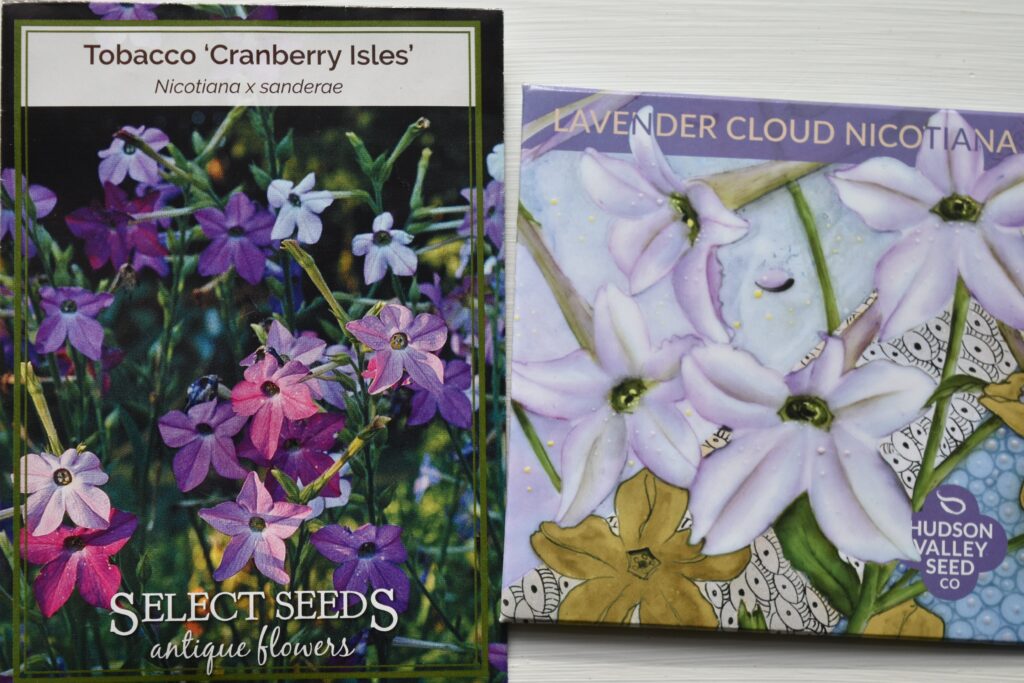
Flowering Tobacco or Nicotiana ‘Cranberry Isles’ from Select Seeds and ‘Lavender Cloud’ from Hudson Valley Seed Co.
Nicotiana flowers are pollinated by night-flying moths. The ones that I love have a delicate look and airily mingle with surrounding plants. The best ones for a Moon Garden are fragrant in the evening – just when you get home from work and are walking around the garden with your favorite drink in hand. Let’s channel our inner summer thoughts as we banish away the last of the winter blues.
Bye for now Gardening Friends. Wishing you a happy Spring . Jenny Rose Carey
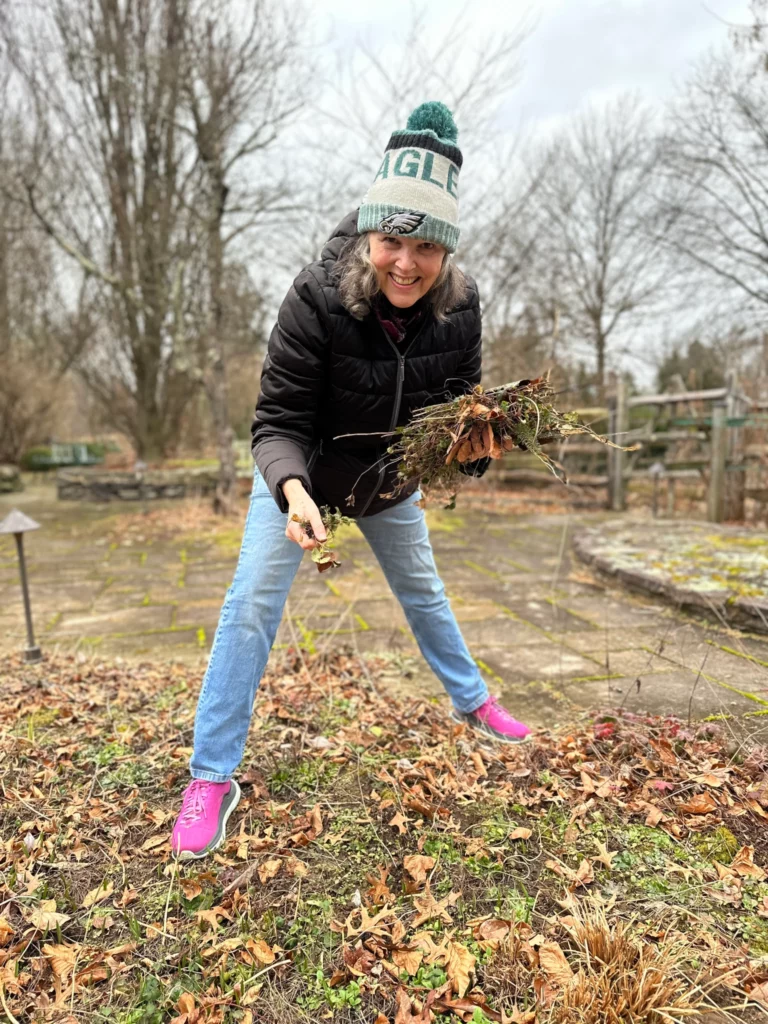
It will soon be spring – Bye for now from Jenny Rose Carey at Northview Garden
Follow me on Instagram @NorthviewGarden and @jennyrosecarey




Leave a Reply